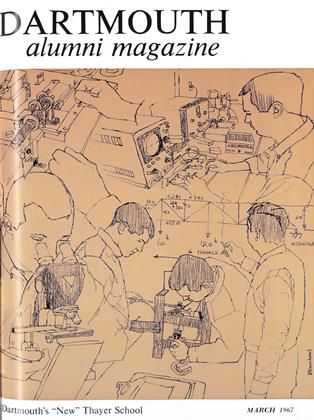By Ken Wlaschin '56.
London: Lutterworth Press, 1966.96 pp.16s.
Ken WLaschin's slim volume in praise of Rome is at first glance a most attractive proposition. Its photographic illustrations, although they come from a variety of commercial, news, and tourist sources, are generally of high quality. They have an engaging way of juxtaposing the formal and monumental aspects of the Eternal City with those surprising human angles which are part of its charm, thanks to Bernini. A recent visitor like myself finds ample material in them for nostalgic reverie; and I can imagine others being lured by them into activating those vague travel plans which have never been realized.
It is only when one penetrates further into the text that a certain element of doubt becomes apparent. The book is one in a series of "Portraits of Cities," and perhaps the ambiguous nature of that title explains the fact that Rome seems to fall between two stools (or should we say "thrones" to suit the grandeur of the subject?). As a portrait the volume is not personal enough. It tries to include the basic notions of history and urban geography that a tourist should have: in the case of the rise and fall of the Roman empire in two slim pages, this is less than satisfactory.
There are few Berninian "surprises" in Mr. Wlaschin's comments, which are mainly the ones we can find in standard travel guides. The point of view remains rather stubbornly that of the foreign visitor, or the Holiday correspondent. The author's few attempts at entering the Roman spirit through the Italian language are almost all unhappy. "We others" instead of "people like us" for "noiantri," "pasta... literally means paste"; "I beg" for "prego"- these are all the kind of "literal" translation that elementary language teachers wear their red pencils out on. It doesn't take a real Roman, either, to know the difference between a Nuova 500 and a genuine Topolino.
But as a tourist guide as well, the volume has serious flaws. It leaves out too many important places: Santa Maria Maggiore, San Paolo fuori le mura, Santa Maria degli Angeli, San Clemente, to name only a few churches.... There is no index, no real walking-tour organization, and the end-paper maps have an odd way of mixing English and Italian street names: "Conciliation Avenue" with "Via delle Terme di Caracalla."
All in all, this is a pleasant little book, but, except for the confirmed Romanophile to whom any grain is grist for his memory-mill, it's hard to see a clear purpose or audi- ence for it. Is it perhaps an exemplar of that old Roman institution, cited by the author: "dolce far niente"?
Assistant Professor of Frenchand Italian
 View Full Issue
View Full Issue
More From This Issue
DAVID SICES '54
Books
-
 Books
BooksALUMNI PUBLICATIONS
May 1920 -
 Books
BooksALUMNI PUBLICATIONS
January 1921 -
 Books
BooksAlumni Publications
October 1944 -
 Books
BooksFaculty Publications
March 1949 -
 Books
BooksAlumni Articles
OCTOBER 1966 -
 Books
BooksJUDAISM DESPITE CHRISTIANITY. THE "LETTERS ON CHRISTIANITY AND JUDAISM" BETWEEN EUGEN ROSENSTOCK-HUESSY AND FRANZ ROSENZWEIG.
FEBRUARY 1970 By EDWARD MARTIN POTOKER '53










